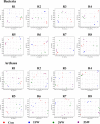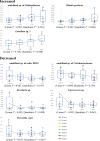Air-Dried Brown Seaweed, Ascophyllum nodosum, Alters the Rumen Microbiome in a Manner That Changes Rumen Fermentation Profiles and Lowers the Prevalence of Foodborne Pathogens
- PMID: 29404417
- PMCID: PMC5793039
- DOI: 10.1128/mSphere.00017-18
Air-Dried Brown Seaweed, Ascophyllum nodosum, Alters the Rumen Microbiome in a Manner That Changes Rumen Fermentation Profiles and Lowers the Prevalence of Foodborne Pathogens
Abstract
The use of Tasco (air-dried Ascophyllum nodosum) as a feed supplement for ruminants has been reported to affect rumen fermentation and reduce Escherichia coli O157:H7 shedding in feces, but the mode of action behind this phenomenon is unclear. In this study, the effects of four Tasco levels (0, 1, 3, and 5%) on rumen microbiota and rumen/fecal E. coli O serogroups in rams were investigated. Rumen total bacteria and archaea were linearly reduced (P < 0.001) and protozoa were linearly increased (P < 0.001) by increasing levels of Tasco. The relative abundances of seven bacterial species and one protozoal species differed among Tasco levels. With Tasco, 14 predicted metabolic pathways were enriched while only 3 were suppressed. A lower ruminal butyrate concentration is possibly associated with enrichment of the "butanoate metabolism" pathway in Tasco-fed rams. The ruminal total E. coli population was linearly reduced (P < 0.001) by Tasco. Supplementation with Tasco only completely eliminated O121 in the rumen and feces, and higher levels of Tasco (3 and 5%) reduced fecal shedding of serogroups O45, O103, and O111 even though these serogroups were present in the rumen. Our results suggest that Tasco effectively reduced pathogenic E. coli but had only minimal impacts on rumen fermentation in rams. IMPORTANCE Maintaining product safety and reducing the carbon footprint of production are two sustainability goals of the livestock industry. The objective of this study was to study the impact of Tasco, a product derived from the brown macroalga Ascophyllum nodosum, on the rumen microbiome and its function. The inclusion of Tasco altered both rumen and fecal microbiota levels without affecting rumen fermentation. Tasco reduced fecal Escherichia coli populations and specifically reduced the prevalence of Shiga toxin-producing E. coli O45, O103, O111, and O121 in feces. The findings of this study highlight the application of Tasco as a potential feed additive to reduce pathogen shedding in rams without interfering with ruminal metabolism.
Keywords: Ascophyllum nodosum; Escherichia coli; Tasco; ram; rumen microbiome; seaweed.
Figures




Similar articles
-
Summer and Winter Prevalence of Shiga Toxin-Producing Escherichia coli (STEC) O26, O45, O103, O111, O121, O145, and O157 in Feces of Feedlot Cattle.Foodborne Pathog Dis. 2015 Aug;12(8):726-32. doi: 10.1089/fpd.2015.1987. Epub 2015 Jun 15. Foodborne Pathog Dis. 2015. PMID: 26075548
-
A Metagenomics Approach to Evaluate the Impact of Dietary Supplementation with Ascophyllum nodosum or Laminaria digitata on Rumen Function in Rusitec Fermenters.Front Microbiol. 2016 Mar 10;7:299. doi: 10.3389/fmicb.2016.00299. eCollection 2016. Front Microbiol. 2016. PMID: 27014222 Free PMC article.
-
Prevalence of Shiga toxin-producing Escherichia coli and associated virulence genes in feces of commercial feedlot cattle.Foodborne Pathog Dis. 2013 Oct;10(10):835-41. doi: 10.1089/fpd.2013.1526. Epub 2013 Aug 2. Foodborne Pathog Dis. 2013. PMID: 23909776
-
Prevalence of Escherichia coli O-types and Shiga toxin genes in fecal samples from feedlot cattle.Foodborne Pathog Dis. 2013 Apr;10(4):392-6. doi: 10.1089/fpd.2012.1289. Epub 2013 Mar 4. Foodborne Pathog Dis. 2013. PMID: 23458025
-
Rumen protozoa and viruses: The predators within and their functions-A mini-review.JDS Commun. 2024 Feb 1;5(3):236-240. doi: 10.3168/jdsc.2023-0433. eCollection 2024 May. JDS Commun. 2024. PMID: 38646576 Free PMC article. Review.
Cited by
-
Selected Alternative Feed Additives Used to Manipulate the Rumen Microbiome.Animals (Basel). 2021 May 25;11(6):1542. doi: 10.3390/ani11061542. Animals (Basel). 2021. PMID: 34070442 Free PMC article. Review.
-
Novel reusable animal model for comparative evaluation of in vivo growth and protein-expression of Escherichia coli O157 strains in the bovine rumen.PLoS One. 2022 May 26;17(5):e0268645. doi: 10.1371/journal.pone.0268645. eCollection 2022. PLoS One. 2022. PMID: 35617366 Free PMC article.
-
Accessing Dietary Effects on the Rumen Microbiome: Different Sequencing Methods Tell Different Stories.Vet Sci. 2021 Jul 19;8(7):138. doi: 10.3390/vetsci8070138. Vet Sci. 2021. PMID: 34357930 Free PMC article.
-
Effects of seaweed extracts on in vitro rumen fermentation characteristics, methane production, and microbial abundance.Sci Rep. 2021 Dec 16;11(1):24092. doi: 10.1038/s41598-021-03356-y. Sci Rep. 2021. PMID: 34916562 Free PMC article.
-
Biological Potential, Gastrointestinal Digestion, Absorption, and Bioavailability of Algae-Derived Compounds with Neuroprotective Activity: A Comprehensive Review.Mar Drugs. 2022 May 28;20(6):362. doi: 10.3390/md20060362. Mar Drugs. 2022. PMID: 35736165 Free PMC article. Review.
References
-
- Callaway TR, Carr MA, Edrington TS, Anderson RC, Nisbet DJ. 2009. Diet, Escherichia coli O157:H7, and cattle: a review after 10 years. Curr Issues Mol Biol 11:67–79. - PubMed
-
- Callaway TR, Anderson RC, Edrington TS, Genovese KJ, Bischoff KM, Poole TL, Jung YS, Harvey RB, Nisbet DJ. 2004. What are we doing about Escherichia coli O157:H7 in cattle? J Anim Sci 82:E93–EE99. - PubMed
LinkOut - more resources
Full Text Sources
Other Literature Sources

